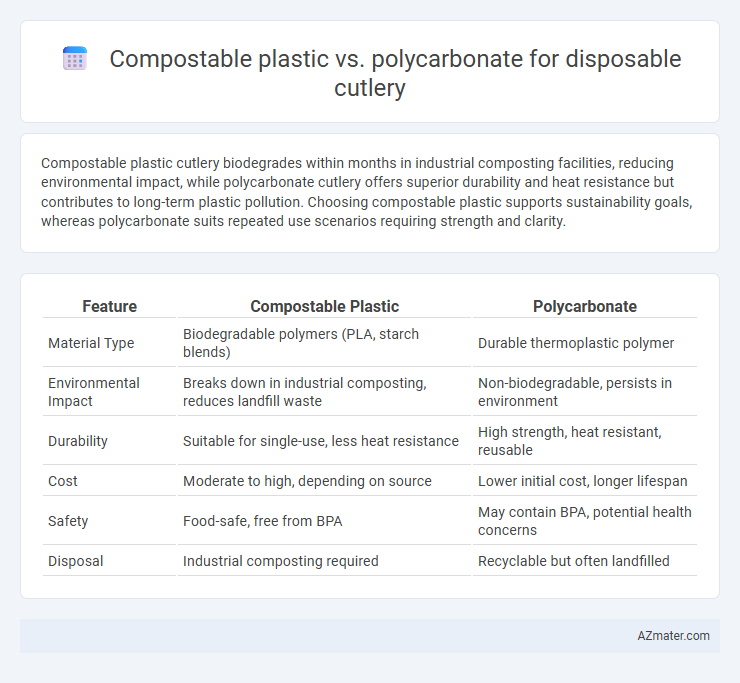Compostable plastic cutlery biodegrades within months in industrial composting facilities, reducing environmental impact, while polycarbonate cutlery offers superior durability and heat resistance but contributes to long-term plastic pollution. Choosing compostable plastic supports sustainability goals, whereas polycarbonate suits repeated use scenarios requiring strength and clarity.
Table of Comparison
| Feature | Compostable Plastic | Polycarbonate |
|---|---|---|
| Material Type | Biodegradable polymers (PLA, starch blends) | Durable thermoplastic polymer |
| Environmental Impact | Breaks down in industrial composting, reduces landfill waste | Non-biodegradable, persists in environment |
| Durability | Suitable for single-use, less heat resistance | High strength, heat resistant, reusable |
| Cost | Moderate to high, depending on source | Lower initial cost, longer lifespan |
| Safety | Food-safe, free from BPA | May contain BPA, potential health concerns |
| Disposal | Industrial composting required | Recyclable but often landfilled |
Introduction to Disposable Cutlery Materials
Disposable cutlery is primarily made from compostable plastics and polycarbonate, each offering distinct material properties and environmental impacts. Compostable plastics derive from renewable resources like cornstarch and break down under specific composting conditions, reducing landfill waste but requiring proper disposal infrastructure. Polycarbonate, a durable petroleum-based plastic, provides high strength and heat resistance but poses environmental challenges due to its non-biodegradable nature and reliance on fossil fuels.
Defining Compostable Plastics
Compostable plastics are bio-based materials designed to break down into natural elements through microbial activity within a specific timeframe, typically under industrial composting conditions. These plastics, often derived from plant starches such as PLA (polylactic acid), convert into water, carbon dioxide, and biomass without leaving toxic residues, making them environmentally friendly alternatives to conventional polymers. In contrast, polycarbonate is a petroleum-based, durable plastic resistant to degradation and not suitable for composting, raising significant concerns regarding landfill accumulation and environmental persistence when used for disposable cutlery.
What is Polycarbonate?
Polycarbonate is a durable, transparent thermoplastic polymer commonly used for disposable cutlery due to its high impact resistance, heat tolerance, and clarity, offering a reusable alternative to traditional plastics. Unlike compostable plastics, polycarbonate does not biodegrade but can be sterilized and reused multiple times, reducing waste over its lifecycle. Its chemical structure allows it to withstand high temperatures without deforming, making it ideal for hot food applications in disposable cutlery.
Environmental Impact Comparison
Compostable plastics used for disposable cutlery significantly reduce landfill waste by breaking down into non-toxic organic matter within months under industrial composting conditions, whereas polycarbonate cutlery, derived from petroleum-based materials, persists in the environment for centuries and contributes to microplastic pollution. Life cycle assessments indicate that compostable plastics generally have lower greenhouse gas emissions and energy consumption during production compared to polycarbonate, which involves energy-intensive synthesis and releases bisphenol-A (BPA), a hazardous chemical. The environmental impact of polycarbonate's disposal pathways, such as incineration or landfill, raises concerns due to toxic byproducts and reduced biodegradability, making compostable plastics a more sustainable option for single-use utensils when managed in proper composting systems.
Biodegradability and End-of-Life Options
Compostable plastic disposable cutlery is designed to biodegrade within industrial composting facilities, breaking down into organic matter within 90 to 180 days, offering environmentally friendly end-of-life options. Polycarbonate cutlery, while durable and reusable, is non-biodegradable and typically ends up in landfills or requires energy-intensive recycling processes, posing long-term environmental challenges. Prioritizing compostable materials significantly reduces plastic waste accumulation and supports circular waste management practices in the disposable cutlery sector.
Safety and Health Considerations
Compostable plastics used in disposable cutlery are typically derived from renewable resources like cornstarch and break down into non-toxic components, reducing environmental impact and minimizing exposure to harmful chemicals. Polycarbonate cutlery, although durable and heat-resistant, contains bisphenol A (BPA), a chemical linked to potential health risks including endocrine disruption when exposed to high temperatures. Prioritizing compostable plastics enhances safety by avoiding BPA exposure and supporting a healthier, toxin-free eating experience.
Functional Performance: Strength and Durability
Compostable plastic disposable cutlery offers moderate strength and biodegradability, but typically lacks the durability and heat resistance found in polycarbonate alternatives. Polycarbonate cutlery exhibits superior tensile strength and impact resistance, ensuring reliable performance during use without bending or breaking. The enhanced durability of polycarbonate supports repeated stress, making it preferable for heavier or extended use scenarios compared to compostable plastics.
Cost and Market Availability
Compostable plastics used for disposable cutlery typically cost 15-30% more than polycarbonate due to biodegradable material processing and limited large-scale manufacturing. Polycarbonate cutlery benefits from established global production infrastructure, making it widely available and inexpensive, with prices as low as $0.03 per piece. The market for compostable plastics is expanding rapidly but remains less accessible, primarily found in niche eco-friendly and premium segments.
Regulatory and Certification Standards
Compostable plastics used in disposable cutlery must comply with ASTM D6400 or EN 13432 certification standards, ensuring biodegradability and environmental safety under industrial composting conditions. Polycarbonate cutlery is subject to FDA and EU regulations for food contact materials, focusing on chemical migration limits and safety to prevent harmful leaching. Regulatory compliance and certification differentiate compostable plastics as eco-friendly alternatives and polycarbonate as durable, reusable options meeting stringent health and safety guidelines.
Which is Better for Disposable Cutlery?
Compostable plastic offers eco-friendly benefits by breaking down naturally within 90 to 180 days, reducing landfill waste and environmental impact. Polycarbonate provides superior durability and heat resistance, making it ideal for reusable cutlery but less sustainable due to its long decomposition period and reliance on fossil fuels. For disposable cutlery, compostable plastic is better suited due to its biodegradability and reduced carbon footprint.

Infographic: Compostable plastic vs Polycarbonate for Disposable cutlery
 azmater.com
azmater.com